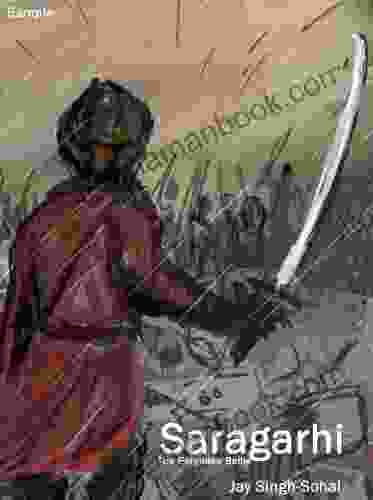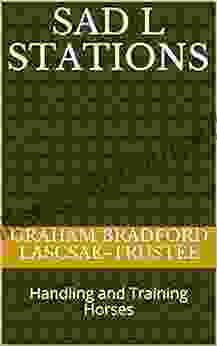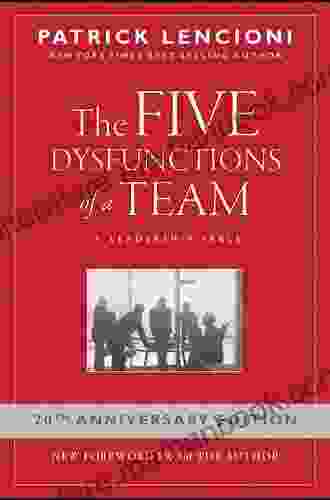Sad Stations Handling and Training Horses

5 out of 5
| Language | : | English |
| File size | : | 2039 KB |
| Text-to-Speech | : | Enabled |
| Screen Reader | : | Supported |
| Enhanced typesetting | : | Enabled |
| Word Wise | : | Enabled |
| Print length | : | 5 pages |
| Lending | : | Enabled |
Horses are magnificent creatures that have been used by humans for centuries for transportation, recreation, and even warfare. However, handling and training horses can be a challenging task, especially for those who are new to the field. Sad Stations Handling and Training Horses provides a comprehensive guide to the techniques and methods used to effectively handle and train horses.
This article covers a wide range of topics, from horse behavior and communication to training principles and techniques. It is essential reading for anyone who wants to learn more about horses and how to work with them safely and effectively.
Horse Behavior
Understanding horse behavior is key to being able to handle and train them effectively. Horses are social animals that live in herds, and they have a complex system of communication. It is important to be able to recognize the signs of fear, aggression, and submission in horses so that you can respond appropriately.
Some of the most important things to know about horse behavior include:
- Horses are prey animals, so they are naturally cautious and easily spooked.
- Horses are social animals, so they need to be around other horses to be happy and healthy.
- Horses communicate with each other through a variety of vocalizations, body language, and facial expressions.
- Horses are intelligent animals, and they are capable of learning a great deal.
Horse Communication
Communication is key to a successful relationship with your horse. Horses communicate with each other and with humans through a variety of vocalizations, body language, and facial expressions. It is important to be able to understand what your horse is saying to you so that you can respond appropriately.
Some of the most common forms of horse communication include:
- Vocalizations: Horses make a variety of sounds to communicate with each other, including whinnies, snorts, neighs, and squeals. Each vocalization has a different meaning, and it is important to be able to recognize the different sounds your horse makes.
- Body language: Horses communicate a great deal of information through their body language. The way a horse stands, moves, and holds its ears and tail can all tell you something about its mood and intentions.
- Facial expressions: Horses also communicate through their facial expressions. The shape of a horse's eyes, nostrils, and mouth can all give you clues about its mood.
Training Principles
Training horses is a complex process that requires patience, consistency, and positive reinforcement. There are a number of different training principles that you can use, but the most effective methods are those that are based on the horse's natural learning process.
Some of the most important training principles include:
- Consistency: It is important to be consistent in your training, both in terms of the commands you give and the rewards you provide.
- Positive reinforcement: Horses are more likely to repeat behaviors that are rewarded, so it is important to use positive reinforcement in your training.
- Patience: Training horses takes time and patience. It is important to be patient with your horse and to avoid getting frustrated.
- Safety: Safety is always the most important consideration when working with horses. Make sure that you are always wearing appropriate safety gear and that you are working in a safe environment.
Training Techniques
There are a variety of different training techniques that you can use to train your horse. The best method for you will depend on your horse's individual personality and learning style.
Some common training techniques include:
- Clicker training: Clicker training is a positive reinforcement training technique that uses a clicker to mark the exact moment that your horse performs the desired behavior.
- Target training: Target training is a positive reinforcement training technique that uses a target to teach your horse to move to a specific location.
- Natural horsemanship: Natural horsemanship is a training philosophy that emphasizes building a relationship with your horse based on trust and respect.
- Traditional training: Traditional training methods use a combination of positive reinforcement and negative reinforcement to train horses.
Sad Stations Handling and Training Horses provides a comprehensive guide to the techniques and methods used to effectively handle and train horses. It is essential reading for anyone who wants to learn more about horses and how to work with them safely and effectively.
By following the principles and techniques outlined in this article, you will be well on your way to developing a strong and lasting bond with your horse.
5 out of 5
| Language | : | English |
| File size | : | 2039 KB |
| Text-to-Speech | : | Enabled |
| Screen Reader | : | Supported |
| Enhanced typesetting | : | Enabled |
| Word Wise | : | Enabled |
| Print length | : | 5 pages |
| Lending | : | Enabled |
Do you want to contribute by writing guest posts on this blog?
Please contact us and send us a resume of previous articles that you have written.
 Top Book
Top Book Novel
Novel Fiction
Fiction Nonfiction
Nonfiction Literature
Literature Paperback
Paperback Hardcover
Hardcover E-book
E-book Audiobook
Audiobook Bestseller
Bestseller Classic
Classic Mystery
Mystery Thriller
Thriller Romance
Romance Fantasy
Fantasy Science Fiction
Science Fiction Biography
Biography Memoir
Memoir Autobiography
Autobiography Poetry
Poetry Drama
Drama Historical Fiction
Historical Fiction Self-help
Self-help Young Adult
Young Adult Childrens Books
Childrens Books Graphic Novel
Graphic Novel Anthology
Anthology Series
Series Encyclopedia
Encyclopedia Reference
Reference Guidebook
Guidebook Textbook
Textbook Workbook
Workbook Journal
Journal Diary
Diary Manuscript
Manuscript Folio
Folio Pulp Fiction
Pulp Fiction Short Stories
Short Stories Fairy Tales
Fairy Tales Fables
Fables Mythology
Mythology Philosophy
Philosophy Religion
Religion Spirituality
Spirituality Essays
Essays Critique
Critique Commentary
Commentary Glossary
Glossary Bibliography
Bibliography Index
Index Table of Contents
Table of Contents Preface
Preface Introduction
Introduction Foreword
Foreword Afterword
Afterword Appendices
Appendices Annotations
Annotations Footnotes
Footnotes Epilogue
Epilogue Prologue
Prologue Harold Robbins
Harold Robbins Shon Peil
Shon Peil Jessie Ash
Jessie Ash Maryann F Kohl
Maryann F Kohl Satyajit Das
Satyajit Das Mike Sibley
Mike Sibley Matt Ridley
Matt Ridley Carrie Ann Ryan
Carrie Ann Ryan Dion Boucicault
Dion Boucicault Emrys Apollo
Emrys Apollo Jeremy Lesniak
Jeremy Lesniak Teresa Torres
Teresa Torres Richard Tashjian
Richard Tashjian Bill Lewis
Bill Lewis Tomohito Oda
Tomohito Oda Martin Philip
Martin Philip William Ayers
William Ayers Margaret Benefiel
Margaret Benefiel John Bates Clark
John Bates Clark Walter R Borneman
Walter R Borneman
Light bulbAdvertise smarter! Our strategic ad space ensures maximum exposure. Reserve your spot today!

 Oliver FosterThrough Fiery Trials: A Novel that Explores Faith, Resilience, and the Power...
Oliver FosterThrough Fiery Trials: A Novel that Explores Faith, Resilience, and the Power... Garrett BellFollow ·4.8k
Garrett BellFollow ·4.8k Herman MitchellFollow ·7k
Herman MitchellFollow ·7k Demetrius CarterFollow ·13.9k
Demetrius CarterFollow ·13.9k Chase SimmonsFollow ·19.5k
Chase SimmonsFollow ·19.5k Gil TurnerFollow ·19k
Gil TurnerFollow ·19k E.M. ForsterFollow ·3.4k
E.M. ForsterFollow ·3.4k Wade CoxFollow ·15.8k
Wade CoxFollow ·15.8k Fabian MitchellFollow ·12.8k
Fabian MitchellFollow ·12.8k

 Melvin Blair
Melvin BlairJames Wade's Captivating Tale: Delving into the Second...
In the heart of a realm where the veil...

 Eric Hayes
Eric HayesFabric Paper Thread: 26 Projects to Stitch with Friends
Get ready to embark on a captivating journey...

 Greg Foster
Greg FosterThe Grammy Awards Record of the Year 1958-2024: A...
The Grammy Awards, the most prestigious...

 Alex Foster
Alex FosterSaragarhi: The Forgotten Battle of the British Empire
On September 12,...
5 out of 5
| Language | : | English |
| File size | : | 2039 KB |
| Text-to-Speech | : | Enabled |
| Screen Reader | : | Supported |
| Enhanced typesetting | : | Enabled |
| Word Wise | : | Enabled |
| Print length | : | 5 pages |
| Lending | : | Enabled |













